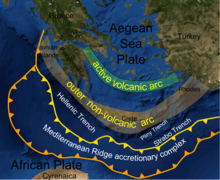
The Hellenic subduction zone (HSZ) is the convergent boundary between the African Plate and the Aegean Sea Plate, where oceanic crust of the African is being subducted north–northeastwards beneath the Aegean. The southernmost and shallowest part of the zone is obscured beneath the deformed thick sedimentary sequence that forms the Mediterranean Ridge accretionary complex.[1] It has a well-defined Wadati–Benioff zone of seismicity, which demonstrates the relatively shallow dip of its southern part, which increases markedly to the north of the non-volcanic part of the Hellenic arc. The descending slab has been imaged using seismic tomography down to the top of the mantle transition zone at 410 km depth.[2]
- ^ Meier, T.; Becker, D.; Endrun, B.; Rische, M.; Bohnhoff, M.; Stőckhert, Harjes; H.-P. (2007). "A model for the Hellenic subduction zone in the area of Crete based on seismological investigations". In Taymaz, T.; Yilmaz, Y.; Dilek, Y. (eds.). The Geodynamics of the Aegean and Anatolia. Geological Society, Special Publications. Vol. 291. pp. 183–199. doi:10.1144/SP291.9. ISBN 9781862392397. S2CID 129674811.
- ^ Blom, N.; Gokhberg, A.; Fichtner, A. (2020). "Seismic waveform tomography of the central and eastern Mediterranean upper mantle". Solid Earth. 11 (2): 669–690. Bibcode:2020SolE...11..669B. doi:10.5194/se-11-669-2020. hdl:20.500.11850/415861.